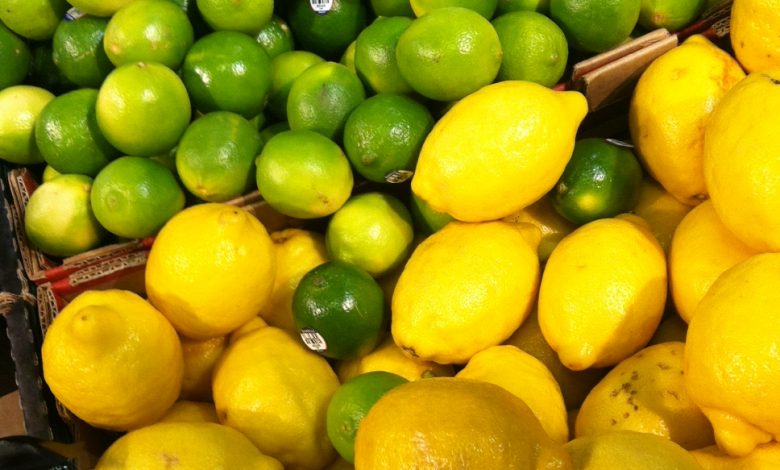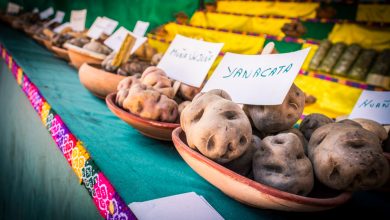Peruvian Limes Hold a Mystery

You may not have noticed it, but you seldom–if ever–see lemons in Peru. Instead, that niche is filled by a Peruvian fruit that resembles limes and is simply called limón, the Spanish word for “lemon”. The cognate of the English lime, lima, is reserved for a very different fruit.
Peru has wonderful limes. They are tart but not as bitter as the limes in the United States, whether persian limes or key limes. They have a broader and more balanced flavor. Their rind is also not as thick and they vary from green to yellowish in external color.
In Peru these are called limón sutil which means subtle lime. Though small like the key lime, it has different flavor profile: broader and richer. What is mostly know as lime in the US is called in Peru limón tahití or limón persa, that is to say Persian or Tahitian Lime.

Not only is the bright yellow lemon, with its distinctive flavor, absent in Peru for all intents and purposes, the same can be said for much of Latin America. The Lime rules from Mexico, where you cannot imagine tacos without wedges of key lime to flavor them, to the end of South America.
Given how important the lemon is in Spanish cuisine, this situation surprises. You would think that the Spanish would have brought lemons with them to the Americas and that they would be found there.

However, this observation is troubled. Spanish cuisine today is not the same as it was shortly after Iberian expansion to the Americas. At the time Spanish food was far more Arabic, especially the food of Andalusia which dominated trade and government in the New World. It was, after all, in 1492 that Spain completed its conquest of Islamic lands in the Iberian Peninsula.
The lime came to Spain along Muslim military and trade routes; it along with other citrus accompanied the mariner Columbus on his voyages.

Evidently, Columbus is responsible for planting limes in the New World, although undoubtedly it came with other voyagers as well. The limes of the New World, as a result, may well represent this early seed stock.
The relative rarity of lemons in the New World, however, suggests that lemons entered Spain after limes came or that limes were strongly associated with ocean going trade and made the crossing while lemons did not.
Another explanation may have something to do with relative preferences for the two fruits in the Spanish colonies.
Of course, it is also possible that the fruit was not clearly differentiated as it is today in English, between limes and lemons. The differentiation in terms of concepts may have taken place more recently.
The Spanish word limón refers to both to this day in the Americas, although in Spain there is the word lima used for limes. In South America this word describes a different fruit, leaving limón for both lemons and limes.
According to Ramón-Laca, evidence from Arabic language and Romance language texts in Muslim Spain shows that the lemons and limes were not strongly distinguished at the time in Spain. The word limón was a generic word and only after the time Columbus sailed did the word lima come into common usage.
As he notes, the various citrus plants hybridize easily and many plants were mixtures. Today in English we separate lemons and limes. We even make the separation in the scientific names: Lemon is citrus limon while the lime is citrus aurantifolia. Nevertheless, it is probable, that when the Spanish came they brought a variety of citrus plants that only later became separated and most of the ones in Latin America developed into limes.

Today, it is hard to see that original diversity. Most of the market in Peru for limes is filled by the production of limón sutil in the northern Peruvian region of Piura. Local forms have diminished and probably even disappeared as the market for this variety has taken off.
Today, the farmers of Piura seek to develop and export Persian limes, as well as their limón sutil, to the United States, as well as to other neighboring countries and even to Peruvian markets.
In any case, there is a mystery here that would benefit from historical work. The current preference for limes and the use of limón to describe them undoubtedly results from much history.
Reference:
L. Ramón-Laca, The Introduction of Cultivated Citrus to Europe via Northern African and the Iberian Peninsula, Economic Botany 57:4:502-514, 2003.





Very interesting David.. I often discuss the lemon vs. lime problem with my new Peruvian son-in-law… now we have some concrete facts to consider!
Thanks, Rob. It is an intriguing issue. I hope all is well with you and yours.
A great, solid article. My Peruvian wife and I once debated what the word “lemon” actually meant, with her insisting that “lemon” was the correct translation for the little key limes ubiquitous in Lima. I believe it’s also just such a tempting false cognate, that she (and others) want to translate the word “limón” as “lemon.”
They actually had big, yellow, ripe American-style lemons sometimes at a store called Vivanda in Lima. I made the mistake of trying to buy one without the sticker on it, and the cashier had no idea what it was. She asked the next cashier and told her the code, and said “es como limón pero más ácido” (it’s like a ‘lime’ but more sour). Another funny moment, as I think many Americans consider limes to be more sour than lemons, but Peruvian limes really are less sour than lemons.
Thank you, Dave
This article seems to forget that on Argentina (southern country in Latin America) the classic Lemon controls the market. The Tahití Lime has become available on this region just in the last years, thanks to the cocktail art (brazilian caipirinhas uses limes, cuban’s cuba libre use lime’s too) and we suddenly can buy those on some shops. Today I bought for the first time peruvian lemons (yellow looking small limes used for ceviche) and will try it on my cocktails. But it’s important to aknowledge that at least on Argentina the Lemon is what we use in the kitchen and in cocktails.